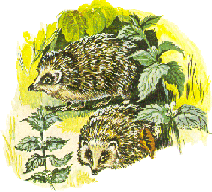
 The
Hedgehog (Gráinneog ) --: The hedgehog is about ten inches long
and is known to most of us
The
Hedgehog (Gráinneog ) --: The hedgehog is about ten inches long
and is known to most of us
It also eats fruit, eggs and young birds. If it can
find no other food, it may sometimes eat the flesh of the dead animals.
While the hedgehog is common through Ireland, it is found mostly in
hedgerows, wood and gardens wherever there are plenty of leaves to hide
under and insects to eat. I have never seen a real hedgehog. Some boys have
seen dead ones on the road. It can often be heard, sniffing its way through
dry leaves in search of to make a clicking noise as it eats an insect or
slug. Up to seven young
are born in nests of grass and moss. Theses nests are on
the ground in well-sheltered places, hedgerows
and woods.
Although blind at birth,
the young quickly learn to follow their mother in search of food. After
three months they
are fully-grown, there are usually two litters a year.
Like the bat, the hedgehog takes a long winter break,
like some boys in our class. Before it settles in for the winter, it stores
up fat in its body by
eating greedily and chooses a
cosy, frost free sleeping
place under a tree stump,
a layer of leaves or even underground.
Ian
Larkin